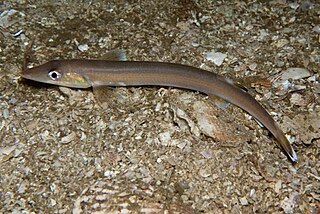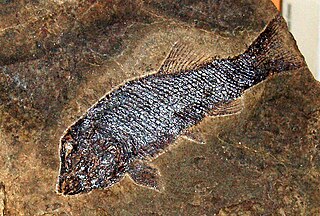
Gonorynchidae is a family of ray-finned fish in the order Gonorynchiformes, which has a number of fossil taxa and one extant genus, Gonorynchus, the beaked salmons. They are an ancient group, with fossils known from as far back as the Albian stage of the Early Cretaceous.
Judeichthys is an extinct genus of prehistoric ray-finned fish that lived during the lower Cenomanian. There is one currently known species, Judeichthys haasi, which was found near Ramallah in Palestine.
Salminops is an extinct genus of prehistoric bony fish that lived during the Cenomanian known from USA and Portugal.
Macrepistius is an extinct genus of prehistoric ray-finned fish that lived during the Albian stage of the Early Cretaceous epoch.
Enischorhynchus is an extinct genus of prehistoric bony fish that lived during the Turonian of southern Texas.
Oligopleurus is an extinct genus of prehistoric bony fish that lived during the Kimmeridgian stage of the Late Jurassic epoch.
Broughia is an extinct genus of marine holostean ray-finned fish that lived during the Induan age of the Early Triassic epoch in what is now Greenland. Fossils were found in the Wordie Creek Formation. A potential concurrent record is also known from Madagascar.
Brachypareion is an extinct genus of prehistoric marine ray-finned fish that lived during the Pennsylvanian epoch. It contains a single species, B. insperatum, known from the Saur Mountains of Kazakhstan. It is placed in the paraphyletic group Palaeonisciformes.

Coelogaster is an extinct genus of marine ray-finned fish that lived during the early Eocene. It contains a single species, C. leptostea, known from the famous Monte Bolca site of Italy.

Aetheodontus is an extinct genus of prehistoric marine bony fish that lived during the early Ladinian stage of the Middle Triassic epoch of what is now Italy and Switzerland. It contains a single species, A. besanensis.
Charitosomus is an extinct genus of prehistoric marine ray-finned fish from the Late Cretaceous, related to modern beaked salmons. They were nektonic carnivores in life.
Caeus is an extinct genus of prehistoric marine ray-finned fish, closely related to the modern milkfish. It contains a single species, C. leopoldi from the Early Cretaceous of the Pietraroja Plattenkalk, Italy. It is one of the largest teleosts known from the Pietraroja formation, and is known by only a single specimen.
Naxilepis is an extinct genus of prehistoric bony fish.
Manlietta is an extinct genus of prehistoric ray-finned fish.
Orvikuina is an extinct genus of prehistoric bony fish.
Pholidoctenus is an extinct genus of prehistoric ray-finned fish.
Pholidolepis is an extinct genus of prehistoric ray-finned fish.
Pholidophoroides is an extinct genus of prehistoric ray-finned fish.

Paralepidotus is an extinct genus of prehistoric ray-finned fish.

Parapholidophorus is an extinct genus of prehistoric bony fish.





